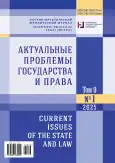Limits of acceptable use of reproduction of museum objects and museum collections
- Authors: Zolotov G.B.1
-
Affiliations:
- Russian State Academy of Intellectual Property
- Issue: Vol 9, No 1 (2025)
- Pages: 56-62
- Section: Issues of Private and Public Law
- URL: https://bakhtiniada.ru/2587-9340/article/view/295221
- ID: 295221
Cite item
Full Text
Abstract
The purpose of the research is to define the boundaries of the acceptable use of reproductions of museum objects and museum collections from the point of view of museum legislation and legislation in the field of copy-
right. The method of comparative analysis of the legal regimes of works of art and museum objects and museum collections was the key research method used to identify the problem related to the boundaries of the acceptable use of reproduction of images of cultural values. The analysis of the ways of using copyright objects, namely reproduction and remake with reproduction as a way of using images of museum objects and collections, is carried out. The method of analogy was also used to identify the possibilities of introducing homage as a new method of use. Based on the results of the study, it was concluded that the concept of “reproduction” from museum legislation is not identical to a similar method of using copyright objects, since reproduction of a museum object and a museum collection additionally implies remake. In addition, homage cannot be a new way for the free use of works of art, since this artistic technique affects not only the exclusive right to the work, but also the personal non-property right of the author – the right to inviolability. The theoretical and practical significance of the work lies in the disclosure of the concepts of “reproduction” and “remake” both from the point of view of copyright legislation and museum legislation, as well as using examples of museum objects and museum collections to analyze the use of homage in the creation of works of art, on the basis of which it is concluded that this artistic technique can not be the basis for the free use of the works.
About the authors
Gennadii B. Zolotov
Russian State Academy of Intellectual Property
Author for correspondence.
Email: zolotov1753@yandex.ru
ORCID iD: 0000-0003-3560-5467
lecturer at the Innovation Management and Intellectual Property Commercialization Department, Post-Graduate Student
Russian Federation, 55a Miklukho-Maklaya St., Moscow, 117279, Russian FederationReferences
- Kamaletdinov D.A. (2021). Reproduction of museum object: concept and content. Mezhdunarodnyi zhurnal gumanitarnykh i estestvennykh nauk = International Journal of Humanities and Natural Sciences, no. 12-1 (63), pp. 11-13. (In Russ.) https://doi.org/10.24412/2500-1000-2021-12-1-11-13, https://elibrary.ru/iaozuf
- Zolotov G.B. (2023). Problems in determining substantive law norms to protect museum objects and collections as intellectual property. Aktual’nye problemy gosudarstva i prava = Current Issues of the State and Law, vol. 7, no 3 (27), pp. 386-394. (In Russ.) https://doi.org/10.20310/2587-9340-2023-7-3-386-394, https://elibrary.ru/ttudug
- Vitko V.S. (2023). Commentary on the legal approaches formed by the intellectual property rights court on derivative works. Zhurnal Suda po intellektual’nym pravam = The Journal of the Intellectual Property Rights Court, no. 3 (41), pp. 44-59. (In Russ.) https://doi.org/10.58741/23134852_2023_3_5, https://elibrary.ru/uoukdm
- Smirnova E.A. (2013). Museums against copyright. Intellektual’naya sobstvennost’. Avtorskoe pravo i smezhnye prava = Intellectual Property, no. 11, pp. 14-22. (In Russ.)
- Egorova A.S. (2023). Homage is a new way of free use of the work. Zhurnal Suda po intellektual'nym pravam = The Journal of the Intellectual Property Rights Court, no. 3 (41), pp. 67-71. (In Russ.) https://doi.org/10.58741/23134852_2023_3_7, https://elibrary.ru/delmgo
- Dragunova S.A. (2019). The right to the inviolability of the creative work and the right to recast it. Sotsi-al’no-politicheskie nauki = Sociopolitical Sciences, no. 3, pp. 165-168. (In Russ.) https://elibrary.ru/tpoldi
- Sudarikov S. A. (2010). Intellectual Property Law. Moscow, Prospekt Publ., 367 p. (In Russ.)
- Dem’yanenko E.V., Shpak A.V. (2023). To the issue of the free use of works as objects of copyright. Yurist’-Pravoved’ = Jurist-Pravoved, no. 1 (104), pp. 48-53. (In Russ.) https://elibrary.ru/nwhwry
- Burdova V.D. (2022). Dualism of the legal nature of museum rights. Trudy po intellektua’'noi sobstvenno-
- sti = Works on Intellectual Property, vol. 41, no. 2, pp. 54-59. (In Russ.) https://doi.org/10.17323/tis.2022.14447, https://elibrary.ru/nvwnrp
- Vitko V.S. (2018). About the features of the concept of “derivative work”. Intellektual’naya sobstvennost’. Avtorskoe pravo i smezhnye prava = Intellectual Property, no. 9, pp. 37-54. (In Russ.) https://elibrary.ru/rxzelt
Supplementary files









